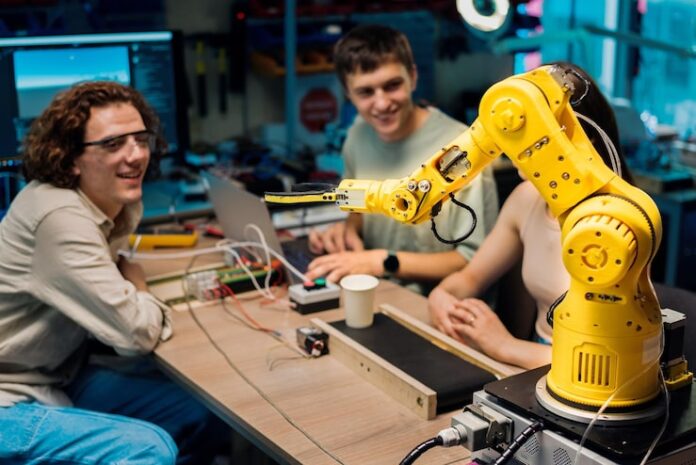Robotics and the Changing World
Robotics is transforming the way humans live, work, and dream. From factory floors to hospital rooms, intelligent machines are no longer the stuff of science fiction. Today, robots weld cars, assist surgeons, deliver packages, and even help children learn coding.
This rapid evolution feels like stepping into a future once imagined only in movies. Yet for engineers, entrepreneurs, and everyday users, the presence of robots is a natural progression of technology. Their impact touches every corner of modern society.
The Origins of Robotics
The roots of Robotics trace back to early automata—mechanical figures designed to mimic human actions. Ancient inventors in Greece and China experimented with self-operating devices powered by water or gears. Centuries later, the Industrial Revolution introduced automated looms and steam-powered machines, paving the way for today’s innovations.
By the mid-20th century, researchers began merging mechanics with computer science. This union gave birth to programmable robots capable of learning and adapting, setting the stage for the complex systems we see now.
Core Components of Robotics Technology
Understanding Robotics means exploring the interplay of hardware and software. A robot’s body relies on sensors, motors, and actuators to move and interact with the environment. Its “brain,” powered by algorithms and artificial intelligence, processes data and makes decisions in real time.
Transitioning from simple tasks like repetitive assembly to sophisticated problem-solving requires advanced machine learning and computer vision. These technologies enable robots to recognize patterns, avoid obstacles, and perform delicate operations with near-human precision.
Robotics in Industry and Manufacturing
One of the most visible applications of Robotics is in industrial manufacturing. Automated arms now assemble smartphones, weld automobile frames, and package goods at lightning speed. This precision reduces errors, boosts productivity, and ensures worker safety in hazardous environments.
Companies in sectors such as automotive and electronics rely heavily on these machines. For example, robotic arms in car plants can operate continuously, improving consistency and reducing production costs while freeing human workers for creative tasks.
Healthcare and Medical Robotics
Healthcare has embraced Robotics with groundbreaking results. Surgical robots assist doctors in performing minimally invasive operations, offering unmatched accuracy and reducing recovery times. Rehabilitation robots help patients regain mobility after injuries, while robotic exoskeletons provide support for those with limited movement.
Hospitals increasingly deploy service robots to deliver medication, disinfect rooms, and guide visitors. These applications not only enhance patient care but also reduce the workload of medical staff, especially in high-pressure environments.
Robotics in Everyday Life
The influence of Robotics extends beyond industrial and medical settings. In homes worldwide, robotic vacuum cleaners, lawn mowers, and personal assistants simplify daily chores. Some families welcome social robots that entertain children, remind elderly relatives to take medication, or monitor security.
Urban areas benefit from delivery drones and autonomous vehicles, reshaping how goods and services reach consumers. These advances illustrate how Robotics quietly integrates into routines, improving convenience and efficiency.
Education and the Next Generation
Education plays a vital role in sustaining the growth of Robotics. Schools introduce children to programming through interactive kits and competitions, sparking curiosity about engineering and science. Universities develop specialized programs to train future roboticists, ensuring a skilled workforce capable of advancing the field.
Hands-on learning, where students build and code their own robots, nurtures problem-solving skills and creativity. This blend of play and innovation inspires the next wave of thinkers who will drive robotics forward.
The Role of Artificial Intelligence
Artificial intelligence is the heartbeat of modern Robotics. AI allows machines to learn from experience, adapt to new tasks, and interact with humans naturally. Speech recognition, facial recognition, and decision-making algorithms enable robots to function in dynamic environments.
For instance, autonomous vehicles rely on AI to interpret traffic patterns and avoid obstacles, while service robots use natural language processing to understand spoken commands. This integration of AI makes robots more capable and independent than ever before.
Ethical Considerations in Robotics
As Robotics becomes more advanced, ethical questions grow. Concerns include job displacement, privacy risks, and the potential misuse of autonomous systems. Balancing innovation with responsibility is crucial to ensure that robots benefit society without causing harm.
Researchers and policymakers debate how to regulate AI-driven machines, focusing on transparency, accountability, and human oversight. These discussions help shape a future where humans and robots coexist safely and productively.
Robotics and the Environment
Innovators are also using Robotics to protect the planet. Autonomous drones monitor wildlife populations, track deforestation, and inspect remote ecosystems. Underwater robots explore coral reefs and deep-sea habitats, collecting data critical for conservation.
In agriculture, robotic systems plant seeds, monitor soil health, and harvest crops efficiently. These technologies reduce waste, minimize chemical use, and support sustainable farming practices worldwide.
Cultural Influence of Robotics
Beyond practical applications, Robotics inspires art, literature, and entertainment. Movies, books, and exhibitions portray robots as both helpers and challengers, reflecting society’s hopes and fears about technology. These stories encourage conversations about identity, consciousness, and what it means to be human.
In many ways, the cultural fascination with robots fuels innovation itself. Engineers often draw inspiration from fictional creations, turning imagination into reality.
Future Trends in Robotics
The future of Robotics promises even greater advancements. Collaborative robots, or “cobots,” already work alongside humans on factory floors, combining human creativity with machine strength. Space agencies deploy robotic explorers to distant planets, gathering data from environments inhospitable to humans.
Emerging fields such as soft robotics focus on creating flexible machines that mimic natural organisms. These innovations could revolutionize healthcare, disaster response, and environmental research.
Real-Life Stories of Robotics Impact
Consider a rural hospital where a surgical robot allows specialists to operate remotely, saving lives in communities once isolated from advanced care. In another example, a small farming village adopts autonomous tractors to increase crop yields, improving food security and livelihoods.
These stories illustrate how Robotics moves beyond theory, offering tangible benefits that reshape economies and improve quality of life.
Robotics as a Force for Human Progress
The ongoing evolution of Robotics showcases the limitless potential of human ingenuity. By combining mechanical engineering, computer science, and creativity, robots have become partners in discovery, productivity, and exploration.
As technology continues to advance, Robotics will remain at the forefront of global transformation—quietly enhancing daily routines, revolutionizing industries, and opening doors to possibilities once thought impossible.
Read also:
sri lanka national cricket team vs bangladesh national cricket team
south africa national cricket team vs zimbabwe national cricket team stats
scorecard cricket
south africa national cricket team vs afghanistan national cricket team match scorecard
criket scorecard

